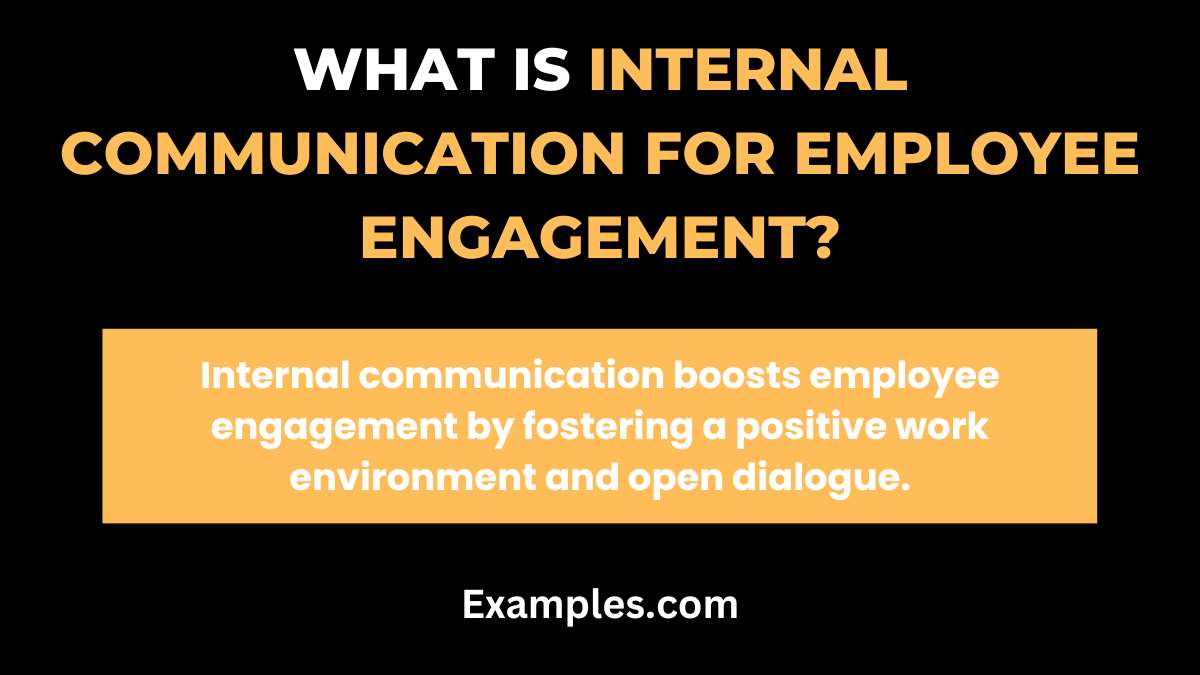14+ Internal Communication for Employee Engagement Examples
Effective internal communication is pivotal for enhancing employee engagement. This guide dives into the nuances of crafting impactful messages and strategies. By exploring various internal communication examples, we illustrate how well-orchestrated communication fosters a positive and productive work culture. From email templates to town hall meetings, this guide covers all facets of internal communication tailored to boost employee morale and engagement. Our focus is on delivering practical, real-world examples that resonate with today’s dynamic work environments.
What is Internal Communication for Employee Engagement?

Internal communication for employee engagement refers to the strategies and methods an organization uses to communicate with its employees. This communication is essential for creating a positive work environment, fostering collaboration, and increasing overall job satisfaction. It involves sharing information, providing feedback, and encouraging open dialogue within an organization, all aimed at enhancing employee involvement and commitment.
15 Internal Communication for Employee Engagement Examples

- Weekly Email Newsletters: Share company updates and celebrate team achievements.
Example: “This week, our team surpassed our quarterly goals! Great job everyone!” - Regular Team Meetings: Foster open discussions about projects and ideas.
Example: “Let’s brainstorm on how we can improve our workflow in our next team meeting.” - Employee Surveys: Gather feedback on workplace satisfaction.
Example: “Your opinions matter. Please fill out the survey to help us enhance our work environment.” - Training Sessions: Offer opportunities for professional growth.
Example: “Join our upcoming training session to develop new skills and advance your career.” - Anniversary Acknowledgments: Recognize and celebrate employee milestones.
Example: “Happy 5-year work anniversary, John! Your dedication is truly valued.” - Interactive Intranet Platforms: Encourage sharing ideas and knowledge.
Example: “Have you checked out the latest post on our intranet about time management?” - Social Media Groups: Create a space for informal interactions.
Example: “Join our Facebook group to connect with colleagues and share your weekend adventures.” - Feedback Mechanisms: Establish channels for constructive feedback.
Example: “We welcome your suggestions on how to improve our project management processes.” - Health and Wellness Programs: Promote a balanced lifestyle.
Example: “Participate in our wellness challenge this month for a healthier you.” - Management ‘Open Door’ Policy: Encourage employees to voice concerns directly.
Example: “Feel free to drop by my office anytime you have a concern or idea to discuss.” - Peer Recognition Programs: Allow employees to appreciate each other’s efforts.
Example: “Nominate a colleague for our monthly Star Employee Award.” - Quarterly Town Hall Meetings: Update employees on company direction and achievements.
Example: “Join us for the quarterly town hall to discuss our company’s future plans.” - Employee Development Plans: Personalize career growth paths.
Example: “Let’s work together on your development plan to align with your career goals.” - Emergency Communication Systems: Ensure timely updates during critical situations.
Example: “In case of an emergency, here’s how we will keep you informed quickly and efficiently.” - Cultural Celebrations: Embrace diversity within the workplace.
Example: “Our annual multicultural day is coming up! Share your culture and traditions with us.”
Importance of Internal Communication for Employee Engagement
Effective internal communication plays a pivotal role in enhancing employee engagement. Here are 10 key points illustrating its importance, each accompanied by an example:
- Boosts Morale: Regular and transparent communication boosts employee morale.
Example: A monthly newsletter celebrating team achievements can uplift spirits. - Promotes a Sense of Belonging: When employees are kept informed, they feel part of the company’s journey.
Example: Sharing company milestones and goals makes employees feel included. - Enhances Transparency: Open communication channels promote transparency.
Example: A Q&A session with top management allows employees to feel heard and informed. - Facilitates Feedback: Encouraging feedback through internal communication helps in addressing concerns.
Example: An anonymous feedback system can surface valuable insights from employees. - Improves Information Flow: Efficient communication ensures that all employees are on the same page.
Example: Regular team meetings ensure everyone is updated on project progress. - Encourages Collaboration: When communication is fluid, collaboration among team members is enhanced.
Example: Cross-departmental meetings to discuss projects improve teamwork. - Builds Trust: Consistent and honest communication builds trust among employees.
Example: Openly discussing challenges and solutions in team meetings builds confidence. - Supports Employee Development: Communicating opportunities for growth and development boosts engagement.
Example: Announcing available training programs encourages personal development. - Reduces Misunderstandings: Clear communication minimizes the chance of misunderstandings.
Example: Detailed email guidelines on project objectives clarify expectations. - Aligns Employees with Company Goals: Effective communication helps align employee efforts with company objectives.
Example: Sharing the company’s vision and how each role contributes to it motivates employees.
How does Internal Communication improve Employee Engagement?
Internal communication significantly impacts employee engagement. Here are 10 points explaining this improvement, each with an example:
- Fosters a Positive Work Culture: Open communication contributes to a positive work environment.
Example: Regular team-building activities communicated well in advance enhance camaraderie. - Provides Clarity and Direction: Clear communication provides employees with a sense of direction.
Example: Detailed job descriptions and objectives help employees understand their roles. - Recognizes and Celebrates Achievements: Acknowledging achievements through internal channels motivates employees.
Example: Highlighting employee successes in internal newsletters boosts morale. - Facilitates Adaptation to Change: Communicating changes effectively helps employees adapt quickly.
Example: Webinars explaining new policies make transitions smoother. - Encourages Innovation and Ideas: A culture of open communication encourages innovation.
Example: Suggestion boxes for new ideas foster a creative environment. - Reduces Workplace Stress: Proper communication can reduce misunderstandings and stress.
Example: Clear instructions on tasks and deadlines prevent confusion. - Promotes Inclusivity: Inclusive communication ensures all voices are heard.
Example: Multilingual internal communications cater to a diverse workforce. - Improves Employee Retention: Good communication can lead to higher retention rates.
Example: Exit interviews can provide insights for improving communication and engagement. - Supports Conflict Resolution: Effective communication helps in resolving workplace conflicts.
Example: Mediation sessions communicated and conducted effectively can resolve issues. - Enhances Job Satisfaction: Employees who are well-informed typically report higher job satisfaction.
Example: Regular updates on company performance help employees feel valued and satisfied.
Role of Internal Communication for Employee Engagement
- Acts as a Motivational Tool: Effective communication can motivate employees by making them feel connected to the company’s achievements.
Example: Sharing success stories of different departments in the company newsletter. - Bridges the Gap Between Management and Staff: Regular communication from management helps in reducing the hierarchical gap.
Example: ‘Coffee with the CEO’ sessions where employees can informally interact with the top management. - Enhances Knowledge Sharing: Internal communication platforms can be used for sharing knowledge and best practices.
Example: An internal wiki where employees share insights and solutions. - Supports Crisis Management: During a crisis, effective communication is vital to maintain employee trust and morale.
Example: Regular updates during a crisis situation to keep employees informed and calm. - Helps in Recognizing and Rewarding Employees: Publicly recognizing employees’ efforts through internal communication channels boosts their engagement.
Example: Announcing employee of the month in the internal newsletter. - Encourages Innovation and Creativity: A communicative environment encourages employees to share innovative ideas.
Example: A suggestion box in the intranet where employees can submit creative ideas. - Maintains a Flow of Information: Consistent internal communication ensures a steady flow of important information.
Example: A weekly roundup email summarizing key events and news within the company. - Creates a Platform for Employee Advocacy: Employees can become brand advocates when they are well-informed and engaged.
Example: Encouraging employees to share their positive work experiences on their social media. - Supports Employee Well-being: Communicating about health and wellness programs shows that the company cares about its employees.
Example: Emails about mental health resources and wellness programs. - Enhances the Company Culture: Regular and effective communication contributes to building a positive company culture.
Example: Celebrating company milestones and achievements through various internal communication channels.
Impact of Internal Communication for Employee Engagement
- Increases Job Satisfaction: Employees who feel informed and included are more likely to be satisfied with their jobs.
Example: Regular performance feedback sessions leading to higher job satisfaction. - Improves Employee Performance: Well-informed employees tend to perform better, as they understand their roles and expectations clearly.
Example: Clear communication about project goals leading to improved team performance. - Reduces Turnover Rates: Effective communication can reduce employee turnover by increasing engagement and satisfaction.
Example: Exit interviews that lead to improvements in internal communications and a reduction in turnover rates. - Strengthens Employee Loyalty: When employees feel connected to their company through communication, they are more likely to be loyal.
Example: Sharing company achievements and involving employees in celebrations fosters loyalty. - Encourages Peer-to-Peer Communication: Encouraging communication among employees strengthens team bonds.
Example: Team-building activities communicated through internal channels. - Helps in Conflict Resolution: Open communication channels can help in resolving workplace conflicts more effectively.
Example: Mediation sessions facilitated through internal communication platforms. - Supports Employee Advocacy: Engaged employees are more likely to advocate for their company, boosting its image.
Example: Employees sharing positive work experiences on social media due to high engagement levels. - Enhances Customer Service: Engaged employees often provide better customer service, reflecting positively on the company.
Example: Training sessions communicated internally leading to improved customer service skills. - Facilitates Adaptability and Flexibility: Regular communication helps employees adapt to changes more readily.
Example: Communicating new work policies that require adaptability and flexibility. - Builds a Supportive Work Environment: Effective communication creates a supportive work environment, beneficial for employee engagement.
Example: Regular wellness check-ins via internal communication channels promoting a supportive atmosphere.
Each of these points underlines the significant role internal communication plays in enhancing and maintaining employee engagement, ultimately contributing to the success and well-being of the organization and its members.
Internal communication is a cornerstone of employee engagement. By implementing effective communication strategies and embracing diverse methods, organizations can foster a positive, inclusive, and productive workplace. This guide offers practical insights and tips to revolutionize internal communication, ultimately leading to a more engaged and motivated workforce.



